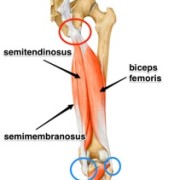Many Missoula runners have already toed the start line of a race or two by now. Training for summer races is in full swing, and now is the time to add intervals, speed work, and mileage. As running speed and intensity increase, however, hamstring overuse injury risk increases. The hamstring is an important and complex, two-joint (crosses both the hip and the knee joints) muscle group used in running. While hamstring pulls and strains are common in runners and often healed with rest, proximal hamstring overuse injuries can be very debilitating. Repetitive micro-trauma in the hamstring attachment at the ischial tuberosity of the pelvis may result in tendinopathy (acute tendinitis or chronic tendinosis) and pain. While proper diagnostic testing is key (clinical testing by an experienced physical therapist or by a sports orthopedic physician), insufficient or improper treatment of proximal hamstring tendinosis can be a season-ending injury.
Understanding the hamstring musculature is the first step toward injury prevention. The two-joint hamstring plays a role in two distinct movements. The hamstring’s primary function is to flex or bend the knee. The hamstring’s secondary function is to aid in extending the hip. Because the hamstring crosses both the hip joint and the knee joint, it is a key muscle in the running stride.
The hamstring is comprised of three muscles. All three hamstring muscles originate on the ischial tuberosity of the pelvis. The semimembranosus and semitendinosus muscles attach on the medial side of the lower leg (tibia) below the knee. The biceps femoris attaches on the lateral side of the lower leg (tibia) below the knee. The hamstring muscle group works in opposition to the quadriceps muscles. When you are flying down a hill at full speed, quads pounding and quads burning, the hamstrings act as the “brakes” to prevent knee hyperextension and to initiate the push-off phase of running.
Once diagnosed with a series of clinical tests by your PT which place tension on the hamstring origin or attachment, establishing proper treatment is crucial. Reducing inflammation by reducing running mileage and stride length must occur first. Strengthening the hamstring in a lengthened state (eccentric) versus a shortened state (concentric) will result in hamstrings which are stronger and more prepared to check the power of the quadriceps while running. Core strength addressing lower abdominal, hip, gluteal, and lumbar strength in a functional manner will complement hamstring-specific strengthening to reduce overuse associated tissue micro-trauma.
Decreasing pain is only one component of a proximal hamstring injury prevention and treatment plan. Strengthening the hamstring in a manner consistent with running is key in preventing injury recurrence. In order to quantify hamstring function, a 2D video running analysis is important to determine how you as an individual run. Are you using your gluteus maximus to extend your hip, or is the hamstring acting primarily? Are you over-striding and placing increased tension through your hamstring? A 2D video running analysis is a helpful way to detect additional underlying running compensations which may influence running biomechanics and resulting hamstring stress.
A physical therapist will customize plan to resolve your hamstring pain. Treatments may include: pain-relieving modalities, integrated dry needling, active release techniques, muscle energy techniques to balance pelvis symmetry, myofascial release, and contract-relax techniques to address pain and tissue restriction in the hamstring secondary to overuse. A cortisone injection may be indicated by your physician if proximal hamstring pain is inflammatory (tendinitis) in nature. Finally, do not forget self-care such as adequate recovery, sleep, release, and eccentric hamstring exercises during the summer running season. The exercises listed below are examples, but I recommend seeing a physical therapist to rule out underlying injuries or referred pain to enable you to resolve symptoms and reduce the risk of re-injury.
Call or email John with any questions or comments.
John Fiore
Sapphire Physical Therapy
406-549-5283
john@sapphirept.com
Proximal Hamstring and Core Exercises:
1. Quadruped plank: May be modified by resting on your forearms. Do not allow your lumbar spine to extend.
2. Side lying glut isolation: Press into the wall with your heel and maintain a neutral pelvis position.
3. Quadruped hip extension: Contract the glut of your involved leg prior to extending your hip to decrease hamstring compensation.
4. Glut bridging: Contract your gluts (glut max) together and hold the contraction as you raise into a bridge position and hold for 5 seconds. Slowly return to starting position and repeat for one minute. Further challenge yourself by repeating glut bridging exercise with the addition of single leg marching without allowing your pelvis to drop.
5. Eccentric hamstring-strengthening exercise using the treadmill: The treadmill is turned on to a slow speed, with the individual facing backward on the treadmill while holding on to the hand rails. The support side (the left leg shown) is placed off of the treadmill belt. The involved leg (the right leg shown) is extended at the hip while keeping the knee mostly extended, and the individual is instructed to resist the forward motion of the belt with the leg as the belt moves. The involved leg then is moved back to the starting point by flexing the knee and extending the hip. Continue for one minute.
References:
1. Cushman, D.; Rho, M., Conservative Treatment of Subacute Proximal Hamstring Tendinopathy Using Eccentric Exercises Performed With a Treadmill: A Case Report. Journal of Orthopaedic & Sports Physical Therapy 2015, 45 (7), 557-562.
2. Fredericson, M.; Moore, W.; Guillet, M.; Beaulieu, C., High hamstring tendinopathy in runners: Meeting the challenges of diagnosis, treatment, and rehabilitation. Physician and Sportsmedicine 2005, 33 (5), 32-43.
*Image from yoganatomy.com





